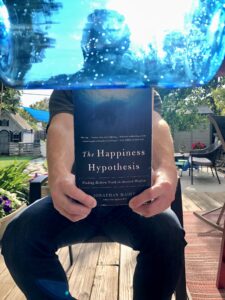 Scholars throughout history have written about happiness: What does a happy life look like? How do we achieve it? Should we be trying to? Obviously, there are no objective answers to these questions, we must all answer them for ourselves. Luckily for those of us living in the 21st century, we have science to help. In this book on happiness, our author Jonathan Haidt (professor of social psychology) combines ancient wisdom and modern social science to help point us in the right direction.
Scholars throughout history have written about happiness: What does a happy life look like? How do we achieve it? Should we be trying to? Obviously, there are no objective answers to these questions, we must all answer them for ourselves. Luckily for those of us living in the 21st century, we have science to help. In this book on happiness, our author Jonathan Haidt (professor of social psychology) combines ancient wisdom and modern social science to help point us in the right direction.
One of the most important ideas developed by modern psychology is what is called the “happiness hypothesis,” and it is an equation that looks like this: Happiness = Setpoint + Conditions + Voluntary Activities.
Our Setpoint is where we start, genetically. It turns out that “happiness is one of the most heritable aspects of personality. Twin studies generally show that from 50 percent to 80 percent of all the variance among people in their average levels of happiness can be explained by differences in their genes rather than in their life experiences.” This is an astounding revelation. The same way that recent research has diagnosed certain types of depression as genetically inherited, so are certain types of happiness.
The Conditions of happiness are about love and work. “We are ultra-social creatures, and we can’t be happy without having friends and secure attachments to other people.” We need loving relationships that make us feel valued. We must also have and pursue the right goals in life “in order to create states of flow and engagement.” Basically, we have to feel a sense of meaning in relationship to others and also to what we spend the bulk of our time doing—hopefully something that contributes to society in what we deem to be a meaningful way. The more loving connections with others we sustain, and the more meaningful we feel as though our work is and our contributions are, the happier we will find ourselves.
Voluntary Activities are also broken down into two categories: pleasures and gratifications. Pleasures are “delights that have clear sensory and strong emotional components” like eating great food, watching great movies, and having great sex. Gratifications are “activities that engage you fully, draw on your strengths, and allow you to lose self-consciousness.” Examples include singing in a choir or having an intense conversation with a friend. They can also be solo activities, like painting, writing, or photography, and are defined by the feeling of ‘flow,’ or total immersion in an activity.
In addition to modern scientific studies, this book also has a collection of ancient wisdom woven in with it. Haidt touches on the similar beliefs of Stoicism and Buddhism which both say that “striving for external goods, or to make the world conform to your wishes, is always a striving after wind,” and that we are better served by breaking attachments to external things and cultivating an attitude of acceptance. He espouses the importance of living a virtuous life and examines the way the Ancient Greeks “focused on the character of a person and asked what kind of person we should each aim to become,” while modern ethics “focuses on actions, asking when a particular action is right or wrong.” He explores the benefits of spirituality, religion, and transcendence, noting that “anyone who wants a full, cross-level account of human nature, and of how human beings find purpose and meaning in their lives,” must recognize that connecting with something larger than the self is an important element in all cultures.
Ultimately, happiness is not something that we can find, acquire, or achieve directly; we “have to get the conditions right and then wait.” Some conditions are within us, our Setpoint. Other Conditions require relationships to things beyond ourselves: Just as plants need sun, water, and good soil to thrive, people need love, work, and a connection to something larger. “If you get these relationships right, a sense of purpose and meaning will emerge,” he writes. Finally, combining these with our Voluntary Activities (how we spend our remaining time) will give us the proper recipe for a happy life: Happiness = Setpoint + Conditions + Voluntary Activities.


